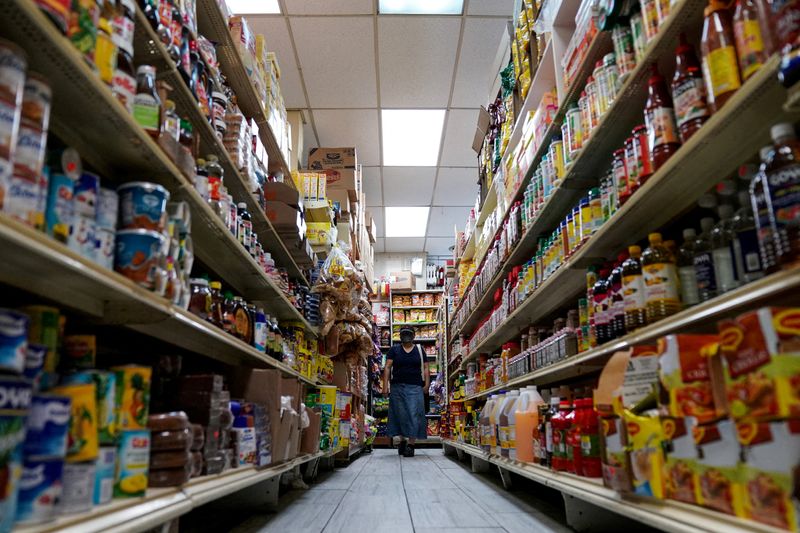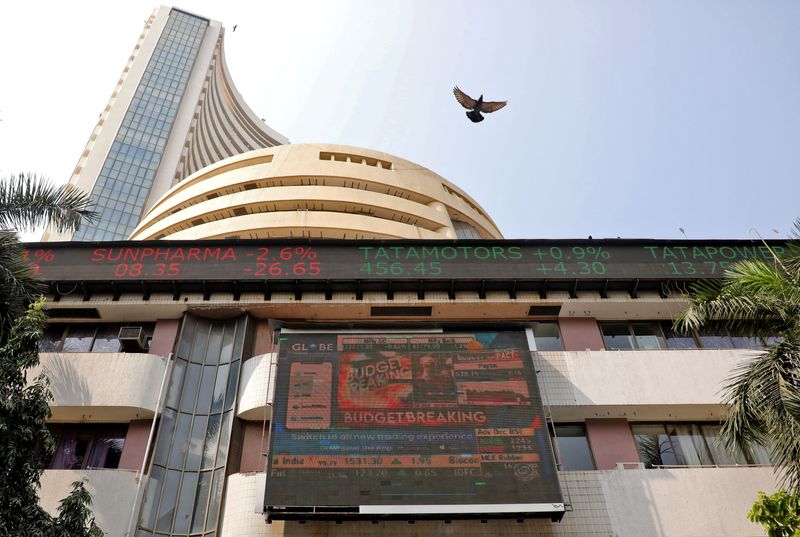Select Language

By David Shepardson
WASHINGTON (Reuters) -The Biden administration said Tuesday it is awarding $521 million in grants to build out electric vehicle charging and deploying more than 9,200 EV charging ports.
The Energy Department and Federal Highway Administration said $321 million will be allocated for 41 community projects that expand EV charging infrastructure, while $200 million will fund 10 corridor fast-charging projects.
Milwaukee will receive $15 million to install EV chargers at 53 sites while Atlanta will receive $11.8 million to install a DC Fast Charging Hub at the city's airport with 50 DC fast chargers providing charging for rental cars, ride-share drivers, and airport shuttles.
The Biden administration has faced harsh criticism for the slow deployment of EV charging stations from a $5-billion U.S. government program created in 2021.
Automakers and others say drastically expanding EV-charging stations is crucial to the wide deployment of electric vehicles, key to U.S. efforts to reduce greenhouse gas emissions.
The White House goal is to grow the nationwide network of chargers to 500,000 ports, including high-speed chargers - no more than 50 miles (80 km) apart - on the nation's busiest highways.
As of August, the United States had 192,000 public charging ports and since the start of the Biden administration, the number of publicly available fast-charging ports has increased by 90%.
FHWA said approximately 1,000 new public chargers being added each week.
In June, just seven EV-charging stations had been deployed under the 2021 U.S. program consisting of a few dozen total charging ports, said Shailen Bhatt, who heads the Federal Highway Administration.

By Daksh Grover
(Reuters) - Gold prices slipped on Wednesday as the dollar ticked up, while investors awaited a key U.S. inflation report due this week for more clarity on the size of a likely September rate cut.
Spot gold fell 0.4% to $2,514.11 per ounce by 0313 GMT. Bullion hit a record high of $2,531.60 on Aug. 20.
U.S. gold futures were down 0.2% to $2,549.00.
The dollar index was up 0.1%, diminishing gold's attractiveness for foreign currency holders. [USD/]
"Market seems to be waiting for a catalyst to ignite the potential bullish breakthrough above that $2,532 level," said Kelvin Wong, OANDA's senior market analyst for Asia Pacific.
The short-term trend for gold remains strong, with the potential to hit new highs. In the longer term, it may face resistance around the $2,585 to $2,595 range, Wong added.
Market participants are looking forward to the release of the U.S. personal consumption expenditure (PCE) data, the Federal Reserve's preferred measure of inflation, on Friday.
Traders have fully priced in a Fed easing for next month, with a 67% chance of a 25-basis-point cut and about 33% chance of a bigger 50-bp reduction, according to the CME FedWatch tool.
Non-yielding bullion tends to thrive in a low-interest-rate environment.
Fed Chair Jerome Powell last week endorsed an imminent start to rate cuts and expressed confidence that inflation is within reach of the U.S. central bank's 2% target.
A report on Tuesday showed that U.S. consumer confidence rose to a six-month high in August but Americans are becoming more anxious about the labour market.
China's net gold imports via Hong Kong in July rose by about 17% from the previous month, the first gain since March, data showed on Tuesday.
Among other metals, spot silver slipped 0.7% to $29.78 per ounce, platinum rose 0.3% to $956.00 and palladium fell 0.4% to $966.40.

By Tom Westbrook
SINGAPORE (Reuters) - Global stocks were poised near record highs on Wednesday, with the next move riding on results at chipmaking market darling Nvidia (NASDAQ:NVDA), while sterling notched a 2-1/2 year high as traders bet that Britain will lag the U.S. in cutting interest rates.
MSCI's broadest index of Asia-Pacific shares outside Japan dipped 0.4%. Japan's Nikkei fell 0.2%.
Oil retraced a recent spike on Middle East tensions as gloom on Chinese demand returned to the fore and Brent crude futures traded just below $80 a barrel. [O/R]
Nvidia's market value has ballooned thanks to its dominance of the computing hardware behind artificial intelligence. The stock price is up some 3000% since 2019 and with a market capitalisation of $3.2 trillion, a move in its shares affects the entire market.
Second-quarter revenue will likely have doubled, though even that may disappoint expectations. Options pricing shows traders anticipate a near 10% - or $300 billion - swing in market value, likely the largest earnings move of any company, ever.
The results at the "so-called 'most important company in the world,'" stand between Wall Street and fresh record highs, noted Capital.com analyst Kyle Rodda, and set the tone for the sector.
"The company’s revenue and sales guidance is a barometer of AI capex, with inferences to be drawn about the health of the other mega-cap tech names," he said.
The S&P 500 went up about 0.2% overnight and futures drifted 0.1% lower in Asia, while Nasdaq 100 futures fell 0.3%.
E-commerce shares stabilised in Hong Kong - where the Hang Seng slipped 0.5% - after taking a kicking following downbeat remarks from discount online retailer PDD Holdings earlier in the week.
China's biggest sportswear maker, Anta, was the top gainer and shares were up 8.5% after better-than-expected profits and $1.3 billion buyback. Shares in Australian gambling company Tabcorp slid 12% and headed for their largest drop since 2020 after the company wrote down asset prices and said rising costs meant it would miss earnings targets.
Debt and currency markets were steady in the Asia session, though the Australian dollar popped up about 0.2% to touch its highest since January at $0.6813 after monthly inflation data was slightly higher than market expectations.
Globally a weakening dollar in anticipation of U.S. rate cuts has lifted most other currencies because markets see U.S. short-term rates, currently above 5.25%, as having furthest to fall. The yen traded at 144.32 per dollar.
Interest rate futures price 100 basis points of U.S. rate cuts this year and last week Fed Chair Jerome Powell endorsed an imminent start to cuts saying "the time has come". The tone contrasts with caution at the Bank of England, which has helped sterling become the top-performing G10 currency with a 4.1% gain for the year-to-date.
It hit its highest in more than two years overnight at $1.3269 and hovered near that level on Wednesday. [GBP/]
"UK services sector inflation...is still uncomfortably high," Rabobank senior strategist Jane Foley said in a note.
"In our view, the BoE is likely to only cut rates once a quarter going forward," she said, against a forecast for four consecutive 25 bp cuts from the Fed from September to January.
Rates markets were steady with 10-year U.S. Treasury yields at 3.83%, two-year yields at 3.87% and the gap between the two its narrowest in nearly three weeks.
Heavy selling in the New York evening drove bitcoin down 4% on the dollar to $59,350. Gold held at $2,517 an ounce.

(Reuters) -Ukraine will temporarily suspend payments on GDP warrants starting from May 31, 2025, according to government decision published on the official website late on Tuesday.
Kyiv will also temporarily suspend payments for loans from Cargill Financial Services International, Inc, starting from Sept. 3, and on government-guaranteed bonds of Ukrainian power firm Ukrenergo starting from Nov. 9, according to the document.
The GDP warrants and private debt obligations are not part of the country's sovereign restructuring deal that the government of the war-torn country is expected to finalise any time now.
With the Russian war in Ukraine now in its third year, the Kyiv government relies heavily on foreign financial aid to be able to finance its social and humanitarian payments. The bulk of Ukraine's state revenues goes to defence efforts.
The GDP warrant, an instrument linked to the country's economic output growth was created during Ukraine's 2015 debt restructuring in the wake of Russia's annexation of Crimea as a sweetener to creditors. JPMorgan calculates that Ukraine owes $2.6 billion on this instrument.
About $700 million is owed to U.S. agribusiness giant Cargill and the state grid company Ukrenergo has a government guarantee on a $830 million note.

By Lucia Mutikani
WASHINGTON (Reuters) - U.S. consumer confidence rose to a six-month high in August amid optimism over the economic outlook, but Americans are becoming more anxious about the labor market after the unemployment rate jumped to near a three-year high of 4.3% last month.
The better-than-expected reading in consumer confidence, reported by the Conference Board on Tuesday, reflected improved perceptions of business conditions over the next six months, and the survey suggested the odds of a recession had continued to decline. Consumers' uneasiness over the labor market is mirrored by concerns at the Federal Reserve, with Fed Chair Jerome Powell last Friday signaling interest rate cuts were imminent.
"This report supports a rate cut on both the decline in inflation expectations and a softening labor market, but is not so weak as to suggest a recession at this point," said Conrad DeQuadros, senior economic adviser at Brean Capital.
The Conference Board's consumer confidence index increased to 103.3 this month, the highest level since February, from an upwardly revised 101.9 in July.
Economists polled by Reuters had forecast the index would be little changed from the previously reported 100.3. Confidence was higher among consumers aged 35 years and older, and those with annual incomes above $100,000.
The cutoff date for the survey was Aug. 21. The rise in confidence could have been influenced by President Joe Biden dropping out of the November presidential race and the nomination of Vice President Kamala Harris to head the Democratic Party ticket.
The Conference Board made no mention of any political impact. The University of Michigan this month, however, attributed the rise in its consumer sentiment measure in August to increased optimism among Democrats compared with Republicans.
Former President Donald Trump is the Republican Party candidate in the upcoming election.
The Conference Board's Expectations Index, based on consumers' short-term outlook for income, business, and labor market conditions, improved to 82.5. That was the highest level since August 2023 and was up from 81.1 in July. It was the second straight monthly reading above 80. A reading below 80 usually signals a recession ahead.
Consumers were less upbeat, however, about the labor market. The share of consumers who viewed jobs as "plentiful" slipped to 32.8% from 33.4% in July. Some 16.4% of consumers said jobs were "hard to get," up from 16.3% last month.
The survey's so-called labor market differential, derived from data on respondents' views on whether jobs are plentiful or hard to get, fell to 16.4, the narrowest since March 2021, from 17.1 in July. This measure correlates to the unemployment rate in the Labor Department's monthly employment report. The unemployment rate has risen for four straight months.
"While we wouldn't necessarily use it to predict month-to-month changes in the unemployment rate, the fact that it keeps worsening is not a good development," said Abiel Reinhart, an economist at J.P. Morgan, referring to the labor market differential. "The message here is that the July unemployment increase was not just a fluke."
Stocks on Wall Street were little changed. The dollar fell against a basket of currencies. U.S. Treasury yields rose.
RATE CUTS COMING
Consumers' 12-month inflation expectations dropped to 4.9%, the lowest level since March 2020, from 5.3% in July. Financial markets expect the U.S. central bank to kick off its easing cycle next month with a 25-basis-point rate reduction, though a half-percentage-point cut cannot be ruled out.
The Fed has maintained its benchmark overnight interest rate in the current 5.25%-5.50% range for more than a year, having raised the policy rate by 525 basis points in 2022 and 2023.
With job growth ebbing, consumers were more pessimistic on their income prospects over the next six months.
The share of consumers expecting their incomes to increase fell to 16.9% from 17.2% in July. The proportion anticipating a decline rose to 12.7% from 11.6% last month.
Rising worries about finances weighed on buying plans for the next six months. At face value that would suggest softer consumer spending in the months ahead, but there is not a strong correlation between confidence and spending.
"Politically-driven shifts in sentiment tend to be poorly correlated with spending decisions," said Oliver Allen, senior U.S. economist at Pantheon Macroeconomics.
Buying plans for motor vehicles fell as did those for major household appliances. The share of consumers intending to purchase a house was the smallest since early 2013.
Higher mortgage rates and home prices have pushed the dream of owning a home out of the reach of many Americans.

By Jihoon Lee, Cynthia Kim and Joyce Lee
SEOUL (Reuters) - As South Korea scrambles to halt the sharp decline in its birth rate, policymakers are having a hard time convincing many in their 20s and 30s that parenthood is a better investment than stylish clothes or fancy restaurants.
Asia's fourth-largest economy plans to launch a new government ministry dedicated to demographic challenges after years of incentives failed to ease the baby crisis.
But for Park Yeon, a 28-year-old fashion Instagrammer and aspiring singer, spending choices are guided mostly by her appetites for clothing and travel, leaving little budget for marriage and babies.
"I'm all about YOLO (you only live once)," said Park as she sells her Supreme T-shirts at a thrift fashion festival in Seoul's high-fashion enclave of Seongsu-dong.
"There isn't enough left to save each month after I do things to reward myself. Getting married might happen at some point but being happy right now - that's more important, right?"
South Korea continues to break its own record for having the world's lowest birth rate, which hit a fresh low last year.
Sociologists say the lifestyle priorities of Koreans in their 20s and 30s - considered Generations Y and Z - mean they spend more and save less on average than the wider population or their peers in other countries, neither of which are conducive to nest building.
"They are status hunting. Their high spending habits show young people are working on their own emblems of success online rather than focusing on the impossible goals of settling down and have children," said Jung Jae-hoon, a sociology professor at Seoul Women's University.
Not even South Korea's aggressive interest rate hikes over the past three years have been able to rein in youthful spending.
The savings rate for those in their 30s declined to 28.5% in the first quarter from 29.4% five years ago, while that for all other age groups increased in the same period, central bank data shows.
At the same time, people in their 20s and 30s make up the biggest spenders at department stores and top-tier hotels while their travel spending rose to 40.1% from 33.3% in the past three years.
The proportion of spending by those in their 20s at high-end department stores has almost doubled to 12% in the three years to May, data from Hyundai (OTC:HYMTF) Card shows, while that for all other age groups declined.
Last year alone, revenue at pricey buffet restaurants jumped 30.3%, versus a gain of 10.5% at fast food restaurants and 9% for the entire dining industry, according to market research firm Euromonitor.
In one example, sales at Seoul Dragon City Hotel - a popular Instagram spot - for its 90,000 won ($68) all-you-can-eat seasonal strawberry dessert jumped 150% from last winter, even after the hotel hiked the price by 12.5%.
In contrast, 25- to 29-year-olds in Australia slashed spending 3.5% in the first quarter of 2024 from a year earlier due to cost-of-living pressure, a report by Commonwealth Bank of Australia (OTC:CMWAY) shows.
Koreans' fancy tastes have made them the world's biggest per-capita spenders on luxury brands, Morgan Stanley's research showed last year, and a hot destination for the biggest luxury brands.
Chanel, Celine and Dior have all signed deals with teen-focused K-pop groups such as Blackpink and NewJeans as global brand ambassadors.
PLEASURE AND PAIN
To be sure, financial hardship is by far the biggest reason South Koreans cited for not having children, according to a survey by research firm PMI Co. in May.
About 46% of 1,800 respondents blamed either job uncertainty or education costs for this decision.
That's worsened by annual incomes only rising 2.0% for those in their 20s and 30s last year, slower than the 4.5% increase for all households, according to Statistics Korea.
But Jung added a youth focus on more immediate pleasures also explains why young people don't respond to the government's subsidy-based baby boosting policies.
The Yoon Suk Yeol administration in May announced a plan to create a new ministry to focus on demographic issues, after dozens of policy measures including subsidies to reverse vasectomies, cash support for families with newborns, free taxi rides and longer paid childcare leave failed to reverse the plunging birth rates.
In a survey of 17 advanced countries by the U.S. Pew Research Center in 2021 asking what makes life meaningful, South Korea was the only country where material well-being was the top response. Elsewhere, family or health was the top answer.
For Park, having children is an add-on she may consider if her singing career takes off.
"If things work out well with what I do, savings and getting married and all those will follow. For now, enjoying my life and working on my dream job are my priorities," she said.

By Patturaja Murugaboopathy and Gaurav Dogra
(Reuters) - Foreign investors are unloading their holdings of expensive Indian stocks and turning instead to new listings in primary markets as they seek cheaper exposure to the market and better returns.
Their selling has been driven by profit booking as Indian stocks trade at record highs, and at valuations topping those of most major stock markets.
Investors are pumping money instead into initial public offerings (IPOs), whose valuations are lower and where there is less of a scramble for stocks.
Foreigners have so far sold a net $3.42 billion worth of equities in the secondary market. They purchased a net $1.47 billion through primary market issuances so far this month, according to India's Central Depository Services Ltd.
A Societe Generale (OTC:SCGLY) (SG) report showed foreigners have bought more than $6 billion of stocks on the primary market this year, the highest since 2021.
"Foreign investors are shying from deploying funds into secondary market for long term and seeing better and faster return prospects in the primary market," said Rajat Agarwal, Asia equity strategist at SG.
They are sellers in the secondary market this year partly because earnings growth prospects have moderated, he said.
India's NSE Nifty 50 index has risen 14% this year, and the 12-month price-to-earnings ratio for its large-and-mid cap stocks stands at 24 times, the highest among major global markets, according to LSEG data.
Meanwhile, the Indian primary market has been busy, with IPO listings of $7.3 billion so far this year - the highest in Asia, followed by China's $5.1 billion, according to Dealogic data.
Foreigners are lured by the cheapness of stocks in primary markets.
Jon Withaar, head of Asia Special Situations, Pictet Asset Management, said the valuations tend to be lower in primary markets due to lack of competition from retail, index, ETFs and most types of institutional investors.
"Companies offering IPOs or rights issues tend to price their shares conservatively to ensure a successful launch and attract more investor interest," said Michael Collins, chief executive officer of WinCap Financial.
"This lower valuation may also be seen as an opportunity for foreign investors who believe that these companies have potential for significant growth in the long run".
With the Fed poised to lower interest rates and investors looking to enter riskier markets for higher returns, analysts expect foreigners will continue to use this route to own Indian stocks.

By Qiaoyi Li and Ryan Woo
BEIJING (Reuters) - China's industrial profits grew faster in July buoyed by high-tech manufacturing, even as sluggish domestic demand weighed on the recovery in the world's second-largest economy.
Profits in July jumped 4.1% from a year earlier following a 3.6% rise in June, National Bureau of Statistics (NBS) data showed on Tuesday.
For the January-July period, profits expanded slightly faster at 3.6% compared with 3.5% in the first half, offering some hope of improving momentum amid dreary factory output, export, prices and banking lending numbers earlier in August.
"The mild expansion in industrial profits showed that domestic macro policies are taking effect" as the factory sector is undergoing a transition and upgrade, said Zhou Maohua, a macroeconomic researcher at China Everbright (OTC:CHFFF) Bank.
The high-tech manufacturing sector, including the making of lithium-ion batteries and semiconductors and related equipment, led the earnings growth with a 12.8% rise in the January-July period, the data showed.
Still, "domestic consumption demand remains weak while the external environment is complex and volatile," said NBS statistician Wei Ning, suggesting more efforts were needed to boost domestic demand.
Tamer shipments last month raised a red flag over the country's export-driven recovery and heightened concerns about frail domestic demand.
China's July bank loans recorded the first contraction in 19 years, central bank data showed earlier.
Electric vehicle battery giant CATL recorded faster profit growth in the second quarter, but its revenue fell at a faster clip during the quarter, as EV sales slow in the world's largest auto market.
Amid lacklustre demand, a prolonged housing downturn and employment worries, Beijing is looking to pivot its stimulus toward consumption.
At a cabinet plenary session earlier this month, Premier Li Qiang vowed to boost the economy with a focus on consumption.
State-owned firms booked a 1% rise in profits in the first seven months, foreign firms posted a 9.9% gain, while private-sector companies saw profits up 7.3%, NBS data showed.
Industrial profit numbers cover firms with annual revenue of at least 20 million yuan ($2.80 million) from their main operations.
($1 = 7.1395 Chinese yuan)

BEIJING (Reuters) - China's industrial profits grew faster in July, data showed on Tuesday, even as sluggish domestic demand weighs on the recovery in the world's second-largest economy.
Profits in July jumped 4.1% from a year earlier following a 3.6% rise in June, according to National Bureau of Statistics (NBS) data.
For the January-July period, profits expanded slightly faster at 3.6% compared with 3.5% in the first half, offering some hope of improving momentum amid dreary factory output, export, prices and banking lending numbers earlier in August.
Tamer shipments last month raised a red flag over the country's export-driven recovery and heightened concerns about frail domestic demand.
China's July bank loans recorded the first contraction in 19 years, central bank data showed earlier.
Electric vehicle battery giant CATL recorded faster profit growth in the second quarter, but its revenue fell at a faster clip during the quarter, as EV sales slow in the world's largest auto market.
Amid lacklustre demand, a prolonged housing downturn and employment worries, Beijing is looking to pivot its stimulus toward consumption.
At a cabinet plenary session earlier this month, Premier Li Qiang vowed to boost the economy with a focus on consumption.
State-owned firms booked a 1% rise in profits in the first seven months, foreign firms posted a 9.9% gain, while private-sector companies saw profits up 7.3%, NBS data showed.
Industrial profit numbers cover firms with annual revenue of at least 20 million yuan ($2.80 million) from their main operations.
($1 = 7.1395 Chinese yuan)

By Elizabeth Pineau
PARIS (Reuters) -French President Emmanuel Macron ruled out naming a prime minister from the leftist New Popular Front alliance and will instead start a new round of consultations on Tuesday with parties to try to form a new government, Macron's office said.
Realising a government led by the New Popular Front (NFP) would immediately face a no-confidence vote in parliament from all other parties, Macron will confer with party heads and political leaders, the statement said on Monday. The NFP is a broad alliance of parties ranging from the moderate Socialists to Jean-Luc Melenchon's far-left France Unbowed.
Macron's announcement suggests there is no imminent end in sight to the country's political crisis after he called a shock snap election that delivered an unwieldy hung parliament.
No grouping emerged from the snap election earlier this summer with a majority, with the vote evenly split between the New Popular Front, Macron's centrist bloc and the far-right National Rally.
The New Popular Front won more votes than any other party, and has argued that its candidate, little known civil servant Lucie Castets, should be named prime minister.
Castets told Macron on Friday that the left is entitled to form the next government. The Elysee statement came after the New Popular Front said it would not take part in any new consultations unless it was to discuss Castets' nomination.
Leaders from France's far-right National Rally said earlier on Monday their party will block any prime ministerial candidate from the New Popular Front, narrowing Macron's options to resolve the stalemate.
Marine Le Pen and Jordan Bardella, the political tag team that runs the National Rally, met with Macron on Monday. After their one-hour meeting, Bardella said the NFP was a "danger" for the country.
"The New Popular Front in its programme, in its movements, as well as the personalities who embody it represents a danger to public order, civil peace and obviously for the economic life of the country," Bardella told reporters. "We intend to protect the country from a government that would fracture French society."
It remains to be seen who Macron will turn to. The eventual name, someone with the broadest possible appeal, will still need to win approval from lawmakers, and if they say no, Macron will have to go back to the drawing board.
Macron had until now ignored the New Popular Front's nomination, and a source close to him said he believed the balance of power lies more with the centre or centre-right.
Some possible candidates that Macron is mulling include a conservative regional president, Xavier Bertrand, and former Socialist Prime Minister Bernard Cazeneuve, sources have said. French media recently mentioned Karim Bouamrane, the Socialist mayor of an impoverished Paris suburb, as another possible name.
Le Pen suggested Macron could call a referendum to chart a path out of the chaos, and said she was opposed to a so-called "technical" government of apolitical technocrats, saying "there are only political governments hiding behind technical names."

